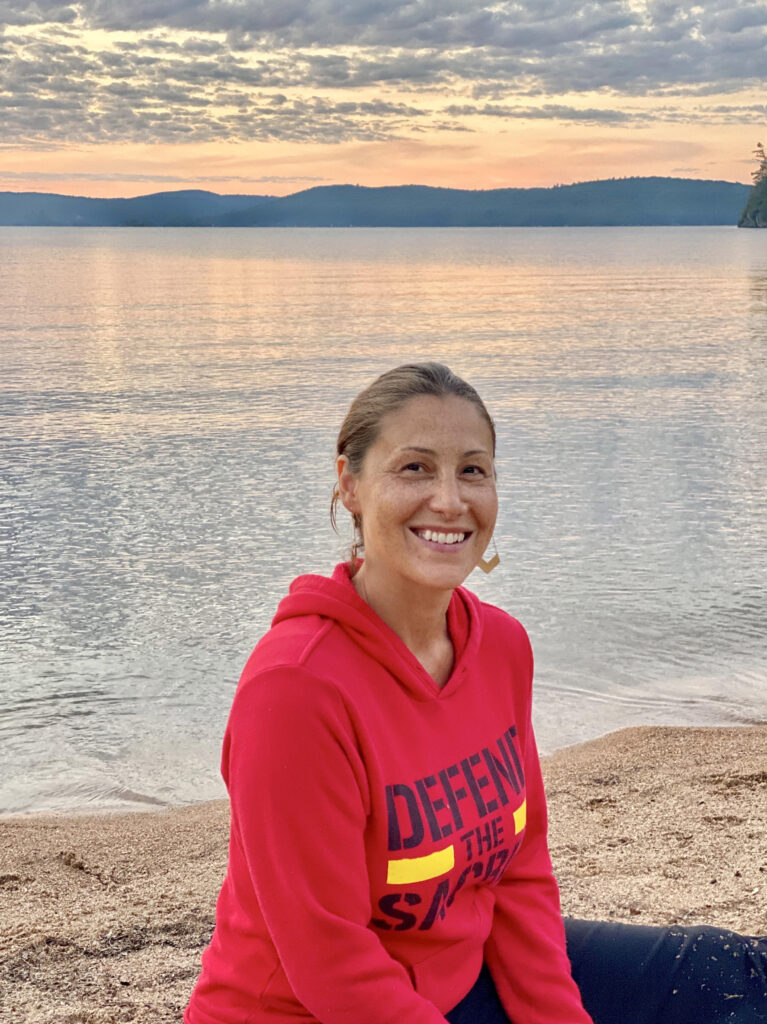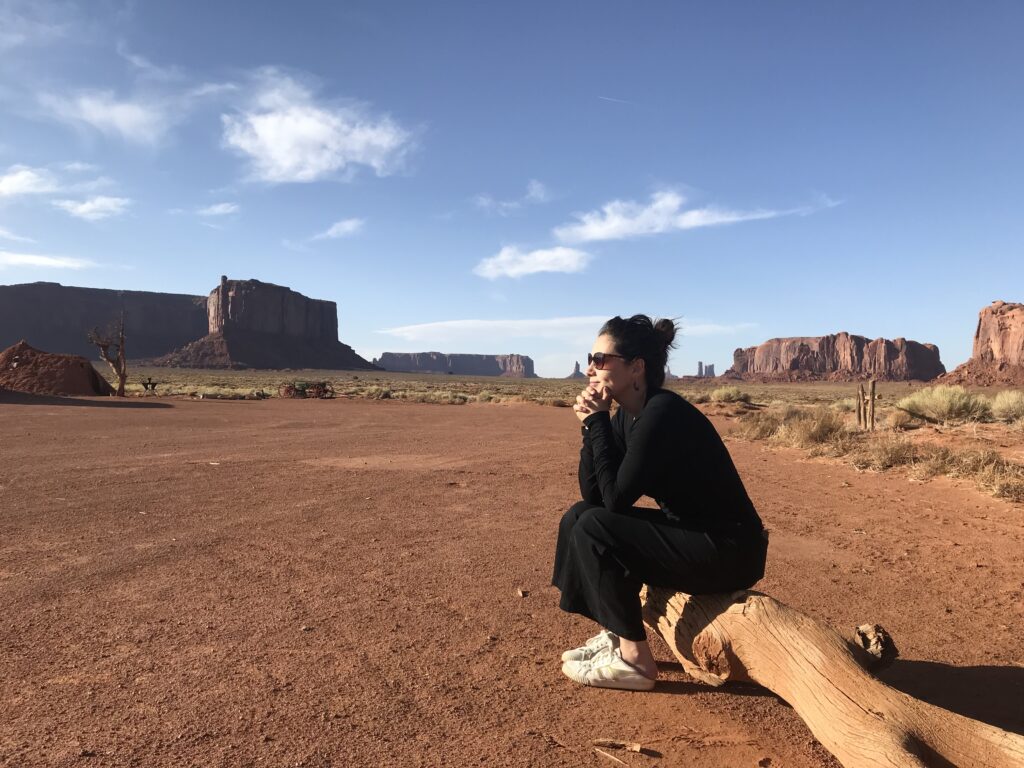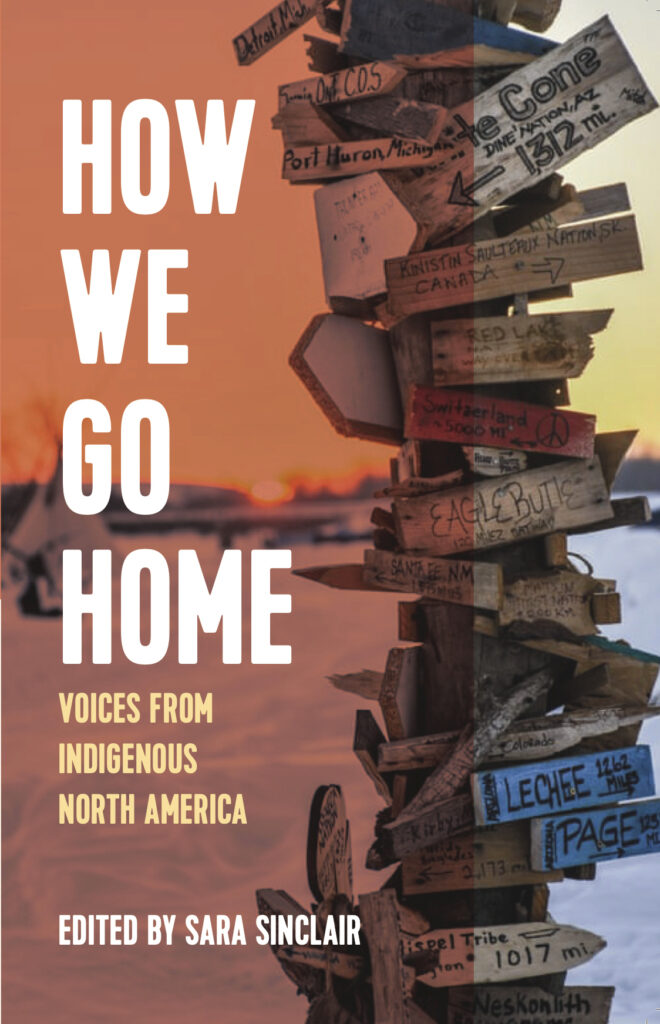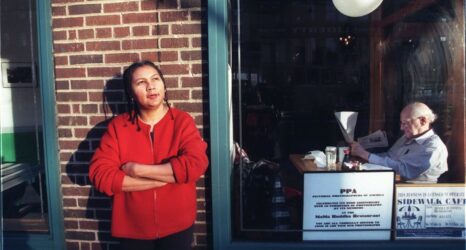What is it like to be a citizen of one nation subsumed within a larger nation whose fundamental economic, social, political and cultural goals are so often at odds? Edited by oral historian Sara Sinclair, How We Go Home: Voices From Indigenous North America aims to answer this question.
This Native American Heritage Month, I hope you’ve been able to read some of the amazing books by Native American writers that were released this year. If not, there’s still time—Because you should not only read books by Native writers this month, you should be reading them all year long!
Anyway, if there’s one book you read this month, make it How We Go Home: Voices From Indigenous North America which is out now by Voice of Witness and Haymarket Books. Edited by oral historian Sara Sinclair (Cree-Ojibwe), How We Go Home is a collection of twelve oral histories by Indigenous people from across Canada and the United States. Accessible and necessary, this volume shines a light on a wide variety of challenges and successes these Indigenous narrators have experienced throughout their lives.
Karla J. Strand had an opportunity to speak with Sara Sinclair about the book, its impact and the power of collective memory.

This interview has been edited for length and clarity.
Karla J. Strand: First of all, Sara, I loved the book. It’s very moving, very candid. Can you say a bit about the book and how the idea for it came about?
Sara Sinclair: It really did feel like this series of serendipitous moments. I discovered this phrase “oral history” in the back of a Dave Eggers novel, [which described] this oral history series that Eggers founded, Voice of Witness.
I started madly Googling about oral history and understanding how it exists in so many different contexts but also how it’s becoming an academic practice. I then realized that I knew what oral history was because on both sides of my family it’s a really important part of culture: I have two grandparents who have participated in more formal oral history projects.
My father’s father was interviewed for the Truth and Reconciliation Commission (TRC) in Canada, which was essentially a huge oral history project that looked into the legacy of the Indian residential schools in Canada. And then my mother’s mother was a German Jewish refugee who was later in her life interviewed by the Shoah Foundation. So again, another huge oral history project, but I wasn’t familiar with [the term oral history]. Somehow it just resonated with me in a way that was ultimately life-changing.
I found the oral history master’s program at Columbia and I arrived with an interest in using it to amplify contemporary Indigenous narratives. That was the area that I felt the most interest in and also the area that I felt the most pressing need. I just was so conscious of the fact that my own experience growing up even in pretty progressive public schools in Toronto, the Native American story was so absent and so I was just really excited about the opportunity to work towards filling a pretty significant gap.
While I was at [Columbia], I did a thesis project [with] a very specific narrative arc: It was interviewing Native Americans specifically—I didn’t interview Canadians at that point—from reservation communities who left their Nations to attend elite academic institutions and then returned home again to work for their Nation.
Ashley Hemmers (Fort Mojave Indian Tribe) was the first person that I traveled to interview for my thesis. I really am not sure that, had that not been the first trip and the first interview, that this path would have unfolded in the way that it did—because the experience that I had with her just really showed me the richness of what this could become. The experience that I had, the way that she acted as a guide to me on her Nation, the hospitality that she showed me and also just the intimacy and the intensity of what she shared with me, I was overwhelmed in the best possible way. I remember feeling like she’s given me this enormous gift and also this enormous responsibility.
It was really those first few interviews that showed me what this project could be because Ashley and Wizipan Little Elk (Rosebud Lakota) were such incredible narrators and educators. I felt if I kept going with this, if I kept traveling the continent and hearing different people’s stories, histories and ways of existing in relation to this land, what a collection this could be! And so that was what I proposed to Voice of Witness and they were very interested.
They wanted to expand the central question to include a greater range of life experiences, so we [came] up with a new central question: What is it like to be a citizen of one nation subsumed within a larger nation whose fundamental economic, social, political and cultural goals are so often at odds?
And that felt like a good question because it allowed me to start conversations with really almost anyone but it had enough of a focus to keep it in line with Voice of Witness’s focus on injustice. So that was the origin story of the project.
Strand: The narratives in the book are so wide-ranging but then still come back to this collective experience of something being taken away or missing or leaving and then returning, which is so powerful. And the method of oral history really overlaps with the oral traditions of many Indigenous cultures and communities.
Sinclair: Oral historians are really interested in memory, of course, and if you think about stories and memory in an Indigenous context, then you’re thinking about the collective memory.
One of the things that I hope that the book conveys is that the collective memory is more complex than just a collection of stories, but each nation and each tribe has their own collective memory, which is basically the culture and contains the stories of how to exist in a certain place. So it’s the story of how to practice ceremony, the stories that contain political systems, the stories that contain the spiritual family, the stories that provide a guide for a particular way of life, a way of life that’s connected to a very specific place on this Earth.
How We Go Home shows how colonialism has interrupted the collective memory, and we see the outcome of that in many different ways in the book. We see the legacy and the intergenerational impact of the different kinds of trauma that have been enacted by both the United States and the Canadian governments. We see how loss of language and culture has affected people’s sense of themselves. We see the higher rates of poverty, addiction and incarceration.
But then also, and what was so important to me from the outset, is we see that return. There isn’t a narrator in this book who’s not in some way working towards restoring that collective memory, that culture, that knowledge, that “village we once had” as Althea Guiboche (Métis, Ojibwe, Saulteaux) calls it [in her narrative in the book].
So I believe that the book is honoring the collective memory, showing how it has been attacked and dismantled and then showing the work that’s being done to restore it.
Strand: Did you have any special considerations regarding representation or the stories that were told? Was the trust harder to build with some more than others or were different topics harder to cover than others?
Sinclair: We thought about representation in a really broad sense, in terms of gender, age, geography, sexual orientation.
I think with respect to gender, there’s a different take on that traditionally within many Indigenous communities, right? This whole idea that there’s a binary is really a colonial construct. It didn’t exist for many nations and Jasilyn Charger speaks about that [in her narrative]. Jasilyn is Two Spirit and in pre-colonial times she would have had really unique and powerful roles to play in her community. She talked about trying to navigate her way through and wanting to bring that pre-colonial value system into her tribe in which, unfortunately, misogyny has trickled down.
The collection process was partly through connection. I think even as an Indigenous person, I was really conscious of the history of extraction that’s occurred in different communities. I was traveling far and wide so I wasn’t known in many of the places that I was traveling to and so trust was very prevalent in my mind. I was very conscious of the fact that I hadn’t done anything yet to earn anybody’s trust. And so I was very careful with that and there were a few things that I did that helped.
I would send them an email: Are you interested? This is what I’m doing. This is my background. This is who I am. Definitely, introductions matter a lot more in an Indigenous context. People wanted to know who I was, who my family was, why I wanted to do this, what I was going to do with it. There needed to be familiarity before the extraction began and there needed to be some sense that this wasn’t just for me. They weren’t giving me the story, they were doing this for a larger common good which they were able to believe in because I also made a practice of sending edited narratives beforehand.
So once someone expressed interest, I would send an edited draft of one of the narratives that I put together for my thesis. I think it showed them that I had integrity, it showed them that I wasn’t looking to put together a collection of sad stories, that I was honoring them and their history, their ideas and their strengths as well.
But also it showed them the extent of the engagement, you know, this isn’t just a little chit chat. This is a big ask and I never wanted to minimize that. So if they read Ashley’s narrative in advance of sitting down for an interview with me, then they would get a really good sense [that narrators were] really sharing some pretty intimate details of their own life story and also reflecting upon the times in a broader social and political way. But I found that to be really helpful with trust.
Strand: I appreciate your point about not collecting or exploiting the sad story. Often researchers, especially settler researchers, collect and share these stories and they become “poverty porn.” The narrators in the book are very candid about their experiences and related times that have included violence, addiction, missing family, and so on—but there are also some really empowering experiences shared like people attending university, going home and supporting their communities, honoring traditions, taking part in resistance efforts: I loved Jasilyn’s narrative about Standing Rock and the youth that were involved in that movement. I think it’s really impactful to witness any sad stories balanced by tremendous successes.
Sinclair: I think honestly that was my greatest fear all the way to the end. I will feel like I have failed so terribly if someone thinks that this is just a collection of sad stories or if it were if anyone thought that this was poverty porn; that would be my worst possible outcome. Because I just feel like this community does not need more of that.
Just the strength that the narrators brought to every encounter I had with them is incredible. Each of them as individuals are so powerful. The power! I mean the power that Jasilyn has as this very young woman and the assurance that she has in telling her story, it’s incredible.
That’s why I love oral history so much: The conversation that you have really does feel to me like a sacred contract. You sit down with this person and you hopefully have been as explicit and as clear as you possibly can about your intention, and they have decided that they’re willing to sit with you in this really intimate, engaged way. And you have this encounter that could only happen in that kind of bonded space and then it’s shared. And so it’s really unique.

Strand: I think this is really important. I also want to make sure that we mention that it’s Native American Heritage Month and we need to be reading these accounts and honoring Native communities and increasing their visibility not only this month, but every day of the year. The book is a great place to begin educating oneself—I’m looking at you, fellow white settlers!—and even includes ideas of what readers can do to help support Indigenous communities.
Care to highlight some of those?
Sinclair: I’m conscious of the fact that I don’t normally see a ton of coverage for [Native American Heritage Month], but I’m seeing less this year because it’s just so drowned out by the noise from the election. I don’t know if you caught the whole CNN graphic mishap where they were trying to show voter representation and it [listed] White, Latino, Black and “something else.” It was just super ironic in this moment when Native Americans have been so engaged in the political process.
I was excited [that] Joe Biden and Kamala Harris both included the Native Americans in their speeches the evening that the election was decided but it’s always last. Like, can we switch up the order once? Could we not always have Native Americans be last? It’s like this very intentional effort at inclusion that just doesn’t feel very authentic, doesn’t feel very heartfelt.
One thing that really struck me when I was working on the book is that I would like people to know a little bit [more about Native Americans]. I got the impression people were afraid to engage [with me] because they didn’t want to reveal how little they knew. And so one of my hopes for the book is that it can provide information so that people feel a little less scared to start those conversations because it will give them that little entryway into all these different topics.
Related to that and this month, you can find out whose land you live on, find out the history of the land. Find out what Indigenous people in the city that you live in are up to. What do they care about? What are they working towards? Just follow a couple of Native thinkers or artists or writers on some of your social media feeds so that you start to have this little piece of your intake come from a unique and different and necessary perspective.
I just wish that there was just a little bit more space in the public consciousness given to the work of Native Americans and to knowing the history and the current desires that Native Americans have.
Strand: And these things take so little effort! We—meaning settlers—need to actually start being more active and intentional with what we’re focusing our attention on.
Sinclair: Yeah, and starting that young. One thing that I didn’t put in the Ten Things You Can Do [list in the book] is getting kids books by Native authors. There are so many beautiful books by Native American and First Nations authors. That’s a very easy starting place. And then as your kid ages, age that reading with them. Louise Erdrich has a series of books for young readers, the first one is called The Birchbark House. You know there’s a way to begin this learning early and then to grow it.
Strand: Right and Debbie Reese has such a great website, American Indians in Children’s Literature, that focuses on books for kids with positive representations of Native American communities and stories. Okay, so what’s next for you and the project?
Sinclair: Right now I’m interviewing on a couple projects for the Columbia Oral History Research Center: I’m interviewing some Indigenous people about Obama’s legacy and Native America and also interviewing some Indigenous folks about their experiences with COVID in New York City.
In January, I’m teaching a course called Indigenous Oral Traditions and Anti-Colonial Oral Histories and I’m really excited about that. And then my next project is just like beginning fantasies right now, but I think what I’m most drawn to is this idea that Winona LaDuke has communicated in a lot of her work, which is that cultural diversity is good for biodiversity. And so I’m really interested in finding a way to use oral history to show these very granular relationships that specific Nations have to specific parts of the natural world. And at the same time using that as a way to show what is sacred.
Strand: I want to thank you and all of the people who shared their stories for this work that has become a beautiful and important book. Do you have anything else you want to add about the experience?
Sinclair: I really feel like there was this amazing collective kind of goodwill that formed around this project and that came from all of the narrators who were such incredible mentors and teachers to me. So I just really want to honor that.
Yes, this was my work over the last three years, but I very much see myself as just the conduit. I think I’m a good interviewer and editor, but they are the heart and I’m just so grateful that each of them was willing to sit with me and be so generous with their time and with their stories.
How We Go Home: Voices From Indigenous North America, edited by Sara Sinclair, is out now from Voice of Witness and Haymarket Books.
You may also like:






